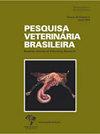Cutaneous fungal infections secondary to avian pox in Northeast Brazil
IF 0.8
4区 农林科学
Q3 VETERINARY SCIENCES
引用次数: 0
Abstract
ABSTRACT: This study describes the epidemiological and clinical-pathological aspects of outbreaks of avian pox diagnosed in poultry associated with fungal co-infections. A retrospective study was carried out, and cases of avian pox with suspected associated fungal infection were selected. The slides were subjected to routine and special histochemical staining in cases of suspected fungal infection, in addition to performing the immunohistochemical technique. Macroscopically, there were nodular lesions with crust formation, and histologically, the lesions were characterized by hyperplasia of the spinous layer associated with multiple eosinophilic intracytoplasmic inclusions. In seven cases, morphologically compatible structures with fungi were verified through black impregnation with GMS and strongly stained in pink with PAS. The morphotintorial aspects were suggestive of fungi belonging to the genus Aspergillus sp. and Candida sp. The diagnosis of fungal co-infections was confirmed through immunohistochemistry, with positive immunostaining for fungi of the genus Aspergillus sp. (five cases) and Candida sp. (two cases). It is concluded that the occurrence of fungal co-infections secondary to the cutaneous lesions of avian pox represents a complicating factor of the disease, favoring the weakness of these animals and death. Therefore, the investigation of associated secondary agents is necessary.巴西东北部继发于禽痘的皮肤真菌感染
摘要:本研究描述了与真菌共感染相关的禽痘暴发的流行病学和临床病理方面。我们进行了一项回顾性研究,并选择了禽痘疑似相关真菌感染的病例。在怀疑真菌感染的病例中,除进行免疫组织化学技术外,还对载玻片进行常规和特殊的组织化学染色。宏观上表现为结节状病变并形成硬壳,组织学上表现为棘层增生伴多发嗜酸性胞浆内包涵体。在7个病例中,通过GMS黑色浸渍和PAS强粉色染色验证了与真菌的形态相容结构。形态染色方面提示真菌属于曲霉属和念珠菌属。通过免疫组化证实真菌共感染的诊断,曲霉属真菌(5例)和念珠菌属真菌(2例)免疫染色阳性。由此得出结论,禽痘皮肤病变继发真菌合并感染的发生是该病的一个复杂因素,有利于这些动物的虚弱和死亡。因此,研究相关的二级药物是必要的。
本文章由计算机程序翻译,如有差异,请以英文原文为准。
求助全文
约1分钟内获得全文
求助全文
来源期刊

Pesquisa Veterinaria Brasileira
农林科学-兽医学
CiteScore
1.30
自引率
16.70%
发文量
41
审稿时长
9-18 weeks
期刊介绍:
Pesquisa Veterinária Brasileira - Brazilian Journal of Veterinary Research (http://www.pvb.com.br), edited by the Brazilian College of Animal Pathology in partnership with the Brazilian Agricultural Research Organization (Embrapa) and in collaboration with other veterinary scientific associations, publishes original papers on animal diseases and related subjects. Critical review articles should be written in support of original investigation. The editors assume that papers submitted are not being considered for publication in other journals and do not contain material which has already been published. Submitted papers are peer reviewed.
The abbreviated title of Pesquisa Veterinária Brasileira is Pesqui. Vet. Bras.
 求助内容:
求助内容: 应助结果提醒方式:
应助结果提醒方式:


